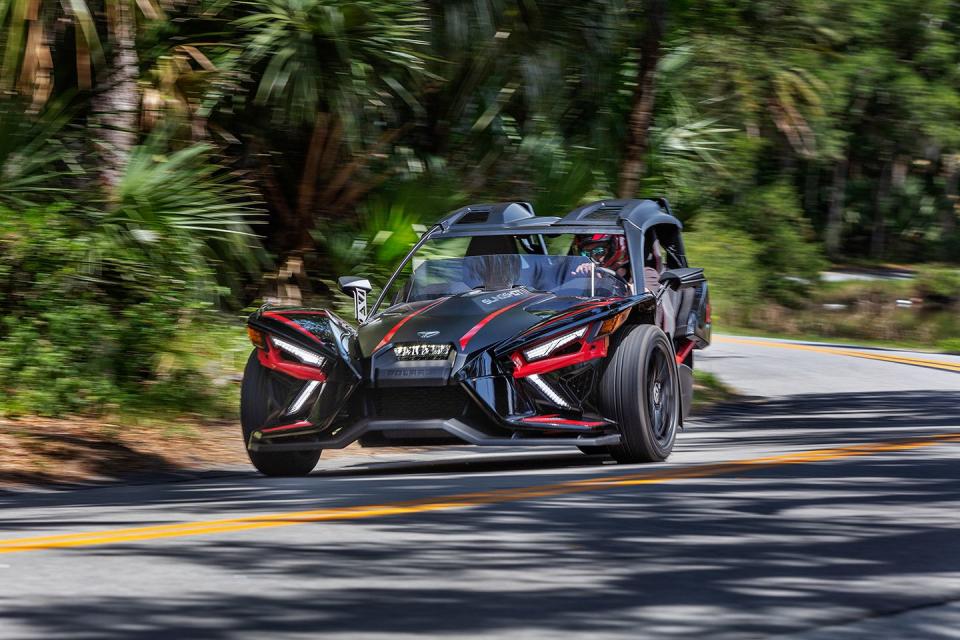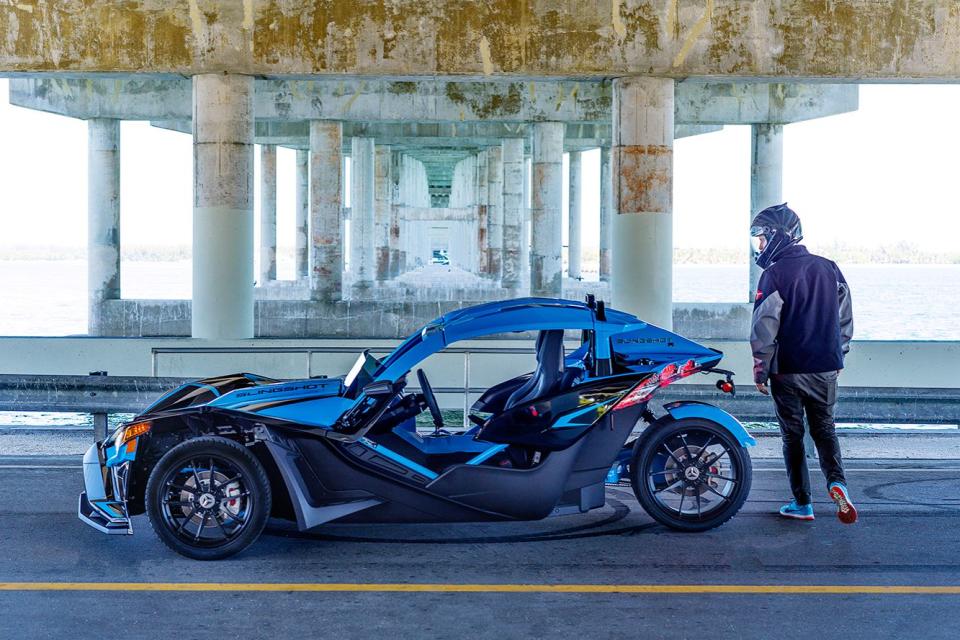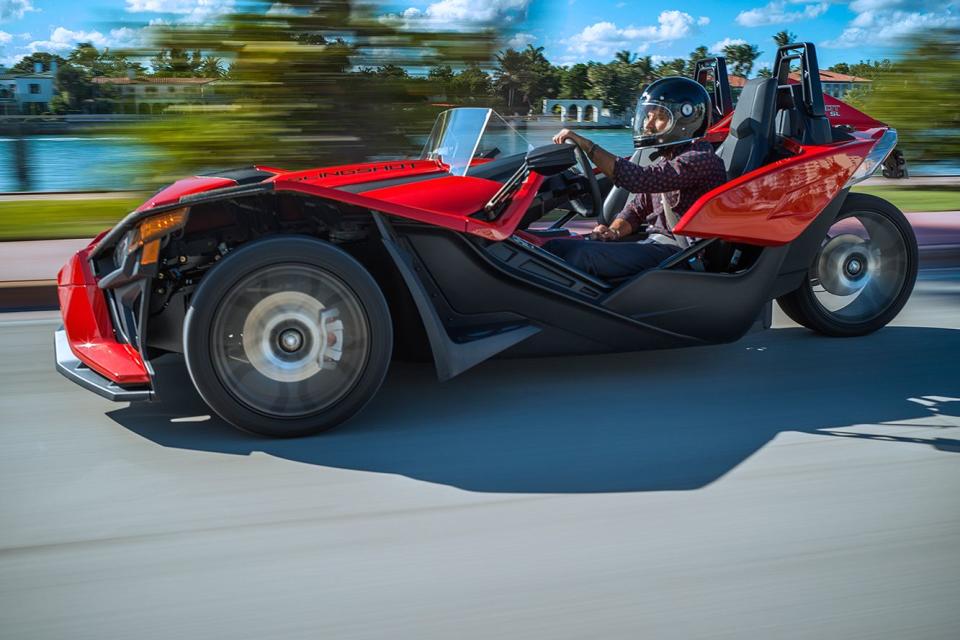2020 Polaris Slingshot Still Perplexes Us
The original Polaris Slingshot, launched in 2015, was a hedged bet: a three-wheeled, Batman-looking two-seater that wasn't fully sure of its mission. Was this a motorcycle surrogate? Was it a stripped-down sports car? Was it a commuter vehicle that shows your local motor vehicles department rep that you play by nobody's rules but your own? Did you need a motorcycle license for this thing or what?
Nobody really knew, least of all Polaris, so it saved some money by powering the Slingshot with General Motors's lazy-revving 2.4-liter Ecotec inline-four. Then it addressed the murky legal designation by sending out lobbyists to argue that this sort of machine shouldn't require a motorcycle license nor any car-type safety and emissions gear. Look, it's probably safer than those Harley trikes, right?

An Appropriate Powerplant
For the 2020 model year, Polaris has finally addressed the power issue, plus a few other things on the Slingshot's to-do list. The most drastic change isn't the bump in power—now 203 horses, up from 173—but the way in which that power is delivered. The new engine, designed in-house for the Slingshot, is a 2.0-liter four with a righteous 8500-rpm redline. This peaky, whirling dervish, dubbed Prostar, makes its power up high, in keeping with the Slingshot's sportbike-inspired attitude. The more powerful iteration, found in the $30,999 R model, hits its horsepower peak at 8250 rpm. The detuned base engine is somehow even more manic, making 178 ponies at 8500 rpm. That's not a stat you see every day—horsepower peak and redline sharing a number. Torque is wispy in either model, with 120 lb-ft in the $26,499 SL model and 144 lb-ft in the R, compared to 166 lb-ft from the old GM tractor engine.

Product planning being what it is, we have to assume there's a whole lot of leeway for horsepower to go much higher, given that, 20 years ago, the Honda S2000 made 240 horsepower with almost the identical displacement and rpm—and that was with full automotive emissions equipment. So, unless every Slingshot has a pair of gym socks stuffed in its intake, we're guessing that 203 horsepower is an extremely malleable number.
Making the Shift
Polaris also worked on the shift action of the standard five-speed manual transmission, adding heft to the shifter and arriving at a nicely notchy action. For the first time, the five-speed manual isn't the sole transmission. A single-clutch, five-speed Magneti Marelli-sourced automated manual has joined the lineup. Standard on the SL and a $1700 option on the R, the AutoDrive transmission is the best argument yet for learning to drive stick.

Remember when Ferrari used to quote shift times for its single-clutch transmissions in milliseconds? This one would need a different unit of time measurement. Like milliminutes. Or epochs. And since there's no manual control whatsoever, the driver has no say over which gear the transmission decides to use. There's a red button on the steering wheel that selects Slingshot Mode, a sort of sport mode that predisposes the transmission to hold gears longer, but that's the extent of your influence over it. There's no launch mode, either, but that's a moot point when you can easily roast the Slingshot's rear tire up to about 30 mph.
Normally we'd assume that such a strange engineering choice—in this case, passing on any number of excellent torque-converter or dual-clutch automatic transmissions—stems from some financial reckoning. But it's not like Italian sequential transmissions are cheap. They are, however, lightweight, and that was the prime consideration. The Magneti Marelli unit adds only 14 pounds to the Slingshot's curb weight, which comes in at a trim Polaris-claimed 1654 pounds for an R with AutoDrive. Either a torque-converter or dual-clutch transmission would have added at least 60 pounds, Polaris says. And that was a no-go, thanks to the Slingshot's status as an "autocycle," a designation that varies from state to state but can include a 1749-pound weight cap.

And Polaris very much wants the Slingshot designated as an autocycle, since those needn't meet automotive safety or emissions regulations, nor do they require a motorcycle license to operate. That's the best of both worlds, if you're a company building a Slingshot sort of thing. As it happens, Polaris lists the "max wet weight" of the Slingshot at 1,749 pounds. What a coincidence! Two states, New York and Massachusetts, still insist that you need a motorcycle license for a Slingshot.
Keeping at It
Once you strap on your helmet (depending, again, on the state), the Slingshot promises a good time. The interior is now much more carlike—leather-wrapped steering wheel, keyless ignition, touchscreen infotainment with navigation, and a Rockford Fosgate audio system that's loud even inside your helmet. While the first Slingshots required frequent steering corrections to follow a straight line, the 2020 model tracks straight and takes a confident set in corners. And the new engine, in manual-transmission R guise, is a blast, exploding above 6000 rpm with a frenetic fizz to redline. Even with its fat 305/30R-20 rear tire, burnouts are inevitable, and the R's quoted 4.9-second zero-to-60-mph time isn't quite representative of how quick the Slingshot feels in the higher gears, since it's so traction-limited off the line. Stability control is completely defeatable, too, should you feel the need to whip that scorpion tail.

At the Slingshot's pyrotechnics-laden debut in Las Vegas, Polaris CEO Scott Wine told dealers that a company's first product in a given market isn't always perfect right away. "When we first came out with the Ranger (Polaris's side-by-side utility vehicle), frankly, it sucked," he said. "But we kept at it, and now we've sold a million Rangers." Polaris might not be looking to sell a million Slingshots, but they sold enough to keep at it. And the latest result is quicker, more fun, and possibly even more extroverted than the original. Lobbyists might be good for something, after all.
You Might Also Like

